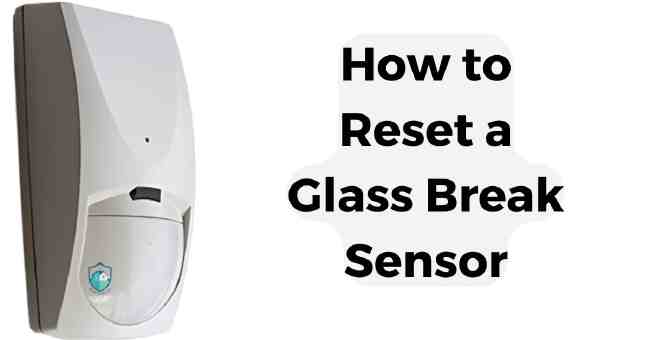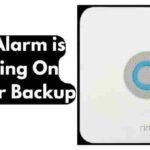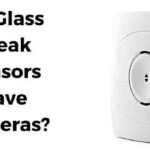Have you ever needed to know how to reset a glass break sensor due to false alarms or other issues? It can be frustrating when these home security devices malfunction and go off for no reason.
A few months ago, my wife accidentally dropped a glass into the kitchen sink while doing dishes, causing a loud crashing sound.
This set off the glass break sensor in our home security system, blasting sirens throughout the house.
In a panic, I rushed to the alarm panel to reset the sensor and turn off the alarm before the monitoring company called the police.
However, I had never actually reset a sensor on the system myself. After fumbling through the manual, I mistakenly hit the “emergency” button first, which triggered an alert to the monitoring company!
I finally found the right code to disarm the system, but not before receiving a call from the security provider.
After troubleshooting, I learned how to properly reset the sensor through the control panel and prevent future false alarms.
In this article, I’ll explain the common reasons you need to reset glass break sensors, walk through the reset steps for different systems, and provide troubleshooting tips to minimize errors.
You’ll know exactly how to get your faulty sensor working again after reading this helpful guide.
Now, Let’s get started
Key Things to Know About How To Reset a Glass Break Sensor
| Device | What it is |
|---|---|
| Glass break sensor | Detects sound of glass breaking and signals security system |
| Security panel/keypad | Controls overall system, use it to reset sensors |
| Reset button | Button on sensor itself you press to reset it |
| Low battery | Main cause of false alarms, so replace battery regularly |
Why Reset a Glass Break Sensor
The most common reasons you may need to reset a glass break sensor include:
- False alarms – Sensors can misinterpret loud sounds as breaking glass and trigger an alarm. Resetting stops the alarm.
- Low battery – When the battery runs low, it can cause false alarms. Replacing battery and resetting will stop this.
- Testing sensor – Resetting lets you test sensor is working after installing or changing battery.
- Power outages – Some sensors reset to a fault mode after losing power. Resetting clears the fault.
Resetting the sensor reactivates it so it can detect future glass breaks but stops any current false alarm.
Locating the Glass Break Sensor
Before resetting a glass break sensor, you need to locate it. Sensors are typically placed:
- Near windows they are monitoring – on windowsills or walls/ceilings nearby
- At least 5 feet away from the window pane
- Around 7-10 feet off the ground
- Away from other objects that can muffle sound
Look for a small white plastic device, usually a few inches long. It will have a button on the front and an opening for the battery.
The sensor will also have a flashing LED light when in alarm mode. This helps identify which one needs reset if you have multiple sensors.
Accessing the Security Panel
Most glass break sensors are part of a home security system. You’ll need to access the main control panel for the system to fully reset sensors.
On many panels, you can silence alarms by entering your security code. But sensors remain in a fault mode until they are reset.
Panels are often located near the main entry door but may be in a basement, bedroom closet, etc. If unsure, check with your security company.
You’ll need your master code to access the full menu options. If you don’t have the code, contact the security company to retrieve it.
Resetting a Glass Break Sensor from the Keypad
Once you’ve accessed the keypad, follow these steps to reset the sensor causing alarm:
- Enter your master security code to silence alarm
- Look for option to view faulted zones – often shown as “Zone Monitor” or “Zone Status”
- Identify zone for the glass break sensor in alarm, shown with an error code
- Select reset option for that zone to clear the error
- Sensor will return to normal standby monitoring mode
Let the panel run through its reset sequence, which usually takes 10-20 seconds.
Resetting the zone clears the fault so the sensor can resume glass break monitoring. The alarm system should indicate reset is complete by listing the zone as clear.
Resetting a Glass Break Sensor from the Device Itself
Most glass break sensors also have a reset button directly on the device. You can use this for a quick reset if the sensor goes into alarm mode.
Press and hold the reset button for 1-2 seconds until the LED light stops flashing. This clears the alarm from the sensor itself.
However, the overall security system may still show a fault. Use the keypad to finish resetting it after pressing the sensor button.
The combination fully resets both sensor and main panel.
Why Reset Sensors from the Keypad
While the sensor’s reset button is handy for a quick reset, it’s better to also use the keypad’s menu for resets when possible.
Resetting only at the sensor doesn’t clear the fault status from the security panel. The panel may still show the zone in error and contact emergency services.
Resetting sensors through the keypad clears faults properly. This avoids false alarms and unnecessary emergency dispatches.
Causes of Glass Break Sensor Alarms and False Alarms
Understanding what triggers glass break sensor alarms can help you prevent and deal with them. Common causes include:
Actual glass breaks – Sensor picks up the sound pattern of breaking glass and triggers an alarm, as intended. This signals a security threat.
Loud noises – Noises like slamming doors, barking dogs, or loud music can mimic glass breaking. This trips the sensor in error.
Electrical interference – Electrical issues, like a wiring short, generate noise that sensors interpret as glass breakage.
Low batteries – Sensors often enter alarm mode with a low battery. Replacing the battery prevents this.
Improper installation – If sensor is installed incorrectly, it can be too sensitive and prone to false alarms. Proper placement is key.
Sensor defects – In rare cases, a sensor malfunctions and starts generating false alarms. May require sensor replacement.
How to Prevent False Alarms
While occasional false alarms are inevitable, you can take steps to minimize them:
- Replace batteries regularly – Low battery is the top cause of false alarms. Proactively swap batteries every 1-2 years.
- Get quality sensors – Units with superior processors and audio analytics have fewer false triggers. Invest in better sensors.
- Test for proper placement – When installing sensors, test different spots and listen for muffling. Position where glass breaks sound clear.
- Insulate around sensors – Add weather stripping tape or insulation foam around sensors to dampen exterior noises.
- Use glass break deterrents – Apply window film or decals that make breaking glass harder. This reduces chance of actual glass breaks.
- Educate family – Teach family about avoiding loud noises near sensors. Turn down music before slamming doors near sensors.
Troubleshooting Faulty Sensors and False Alarms
If a sensor develops chronic false alarms, try these troubleshooting techniques to identify and resolve the issue:
- Swap in new batteries to rule out low power as the problem
- Clean any dirt/debris from sensor microphone openings
- Listen closely to noises right before alarms to pinpoint sound source
- Press reset button when sensor alarms to see if false alarms persist
- Temporarily cover sensor with padding to muffle ambient noise
- Contact installer to check for placement issues, programming errors, electrical interference, etc
- Move sensor slightly to avoid muffling surfaces or problematic acoustics
- Replace sensor if issues can’t be resolved through troubleshooting
Resetting Sensors After a Power Outage
Power outages and surges often cause security systems to revert to a trouble state. When power comes back on, the sensors may show as faulted or inactive.
Resetting techniques vary by security panel model. In general:
- Enter master code to silence any trouble beeps
- Pull up zone status screen to identify faulted sensors
- Select reset option for faulted zones
- Power cycle the main panel if needed
- Ensure sensors show as clear and resume regular monitoring
Wait 10-15 minutes after power restores before resetting sensors. This allows them time to sync back up.
Resetting a Glass Break Sensor After Changing the Battery
Routine battery changes are expected maintenance for glass break sensors. Swapping the battery requires resetting the sensor afterwards.
To reset after a battery change:
- Power down sensor by pressing reset button for 5+ seconds
- Open sensor case and remove old battery
- Insert new battery of same model
- Press reset button again briefly to power on sensor
- Allow 1 minute for sensor to initialize with new battery
- Use keypad menu to reset zone and clear any battery faults
- Confirm sensor is active and working in panel status
Match new battery model exactly to avoid operational issues. Dispose of used batteries properly as many contain toxic materials.
How to Reset Sensors When Installing a New Security System
Adding new security systems requires resetting all connected sensors after initial installation.
Follow your system installation guide to:
- Mount sensors in desired locations
- Power up main panel and create your master code
- Enroll/sync each sensor so panel can detect it
- Trigger each sensor and confirm panel sees the alarm
- Reset sensors through panel menu to set them to active monitoring mode
Test all sensor placements before finalizing install. Adjust locations if any experience chronic false alarms.
Professional Resets and Troubleshooting for Sensors
For ongoing sensor issues or resets after major changes, it can help to bring in a professional.
Security pros have specialized tools to diagnose problems. They can:
- Thoroughly test sensor microphone sensitivity
- Analyze the acoustic response of the room
- Use a computer interface to check sensor settings and signals
- Verify electrical interference isn’t causing problems
- Check for issues with alarm panel programming or communication
- Troubleshoot tricky false alarm causes
They also have experience optimizing sensor placements and reducing false alarms. If you upgrade security systems, the new monitoring company will reset all sensors.
Signaling Emergencies with a Security System
In an actual emergency like a break-in, quickly signal for help using your system’s panic functions:
- Press the panic button on your keypad or security system app
- Trigger a silent duress alarm by entering an emergency code
- Call your security provider’s emergency line if you hear alarms
The alarm monitoring center will dispatch help and notify police.
When to Replace Faulty Glass Break Sensors
If a sensor develops persistent issues that affect its ability to detect glass breaks, replacement is needed.
Warning signs include:
- Frequent false alarms even after troubleshooting
- Failure to alarm when glass is broken during testing
- Inability to resolve problems by resetting the sensor
- Malfunction errors that can’t be cleared
- Older sensors near or past their expected 10 year lifespan
Work with your security company to order and install a comparable new glass break sensor. Properly dispose of old sensors.
Takeaways on Resetting Glass Break Sensors
- Know how to access your security panel and navigate menus to view and reset sensor zones
- Identify the problem sensor from its zone number and flashing LED light
- Press the sensor’s reset button first, then clear the zone fault from the panel
- Replace low batteries proactively to prevent false alarms
- Test sensors after any changes and reset through the panel menu
- Professional help can fix tricky sensor placement and false alarm issues
With some basic troubleshooting skills, you can easily reset faulty glass break sensors and keep your home alarm system working properly.
FAQs
Why Is My Glassbreak Sensor Not Responding?
If your glassbreak sensor stops responding, the most common reason is a low battery. As batteries run down, the sensor can have trouble communicating. Try replacing the battery with a fresh one of the exact same model.
Faulty wiring, improper sensor placement, defective parts, and electrical interference can also prevent the sensor from working properly.
Check for any damage, debris, or installation issues. Relocating the sensor slightly or testing with padding may help isolate the problem.
What Will Set Off A Glassbreak Sensor?
Glassbreak sensors detect frequencies of breaking glass to activate an alarm. Loud banging noises, barking dogs, power tools, slammed doors, revving engines, and even loud music or TV can mimic glass breaking and trigger false alarms.
Actual glass shattering from an intruder or accident will also set off the alarm as intended. Malfunctioning components, low batteries, wiring issues, weather, construction noise, and inadequate placement can cause false alarms.
How Do I Know If My Glassbreak Sensor Is Working?
To test that your glassbreak sensor is working properly, you can use the walk test feature on your control panel.
This will send an alarm signal and trigger the sensor so you can confirm it responds.
You can also listen for the clicking noise the sensor makes when it detects sounds.
Break a small pane of glass out of the sensor’s range to replicate glass breaking. The sensor should click rapidly and the panel should show an alarm.
Can A Sensor Be Reset?
Yes, glassbreak sensors are designed to be reset when they experience false alarms or other errors.
Resetting the sensor reactivates monitoring and clears any alarm or fault signals.
You can reset by pressing the button on the unit itself or using the zone reset option through the security panel menu.
Resetting recalibrates the sensor and allows normal operation again.
Why Is My Glassbreak Sensor Blinking Red?
When a glassbreak sensor has a flashing red light, it means it has been triggered into an alarm state.
This is typically caused by the sensor detecting the frequencies of breaking glass.
However, loud ambient noises, malfunctions, low batteries, or improper installation can also trigger the red blinking alarm light.
Resetting the sensor according to the manufacturer’s instructions should stop the blinking.
What Causes A Sensor To Stop Working?
Glassbreak sensors can stop working due to power loss, defective components, damage, wiring issues, or low batteries.
Improper placement that muffles sound detection can inhibit functionality. Interference from other electronics can also impair sensors.
Older sensors that are past their lifespan may cease functioning due to worn out parts. Environmental factors like moisture, temperature extremes, dust/debris can all impact sensors over time. Proper maintenance helps prevent failure.
Do Glass Break Sensors Go Bad?
Like any electronic device, glass break sensors can eventually fail or “go bad” due to age and wear. Sensors typically last around 5-10 years under normal conditions. The components degrade over time, making false alarms and detection failures more likely.
Signs of a failing sensor include frequently needing to replace batteries, more frequent false alarms, failure to detect actual glass breaks, error signals, or electrical issues.
Replacement is recommended when a sensor can no longer function reliably after troubleshooting.
How Do You Troubleshoot A Faulty Sensor?
Start troubleshooting a faulty glassbreak sensor by replacing the battery to rule out low power.
Clean the sensor openings and listen closely to noises triggering false alarms. Move the sensor slightly in case the placement is picking up echoes or vibrations.
If issues continue, contact your security company to inspect for wiring problems, damage, programming errors, and installation mistakes.
Covering the sensor can help determine if background noises are causing false alarms. Consider relocating the sensor if problems persist in certain areas. Switch out faulty parts or replace defective sensors.
Conclusion
Resetting a glass break sensor is straightforward when you understand the causes of false alarms and how to use your control panel properly.
The main points to remember are to replace batteries regularly, identify the problem sensor, press the reset button first, then clear the zone fault through the menu.
Test after any changes. With some troubleshooting, you can get your home security sensors working again.
Contact professionals for tricky sensor placement issues or unresolved malfunctions. Knowing how to reset glass break sensors provides peace of mind that your system is monitoring properly.





Pingback: How Does Glass Break Sensor Work? - homeprotex
Pingback: Do Glass Break Sensors Have Cameras? -
Pingback: How To Change Battery In Glass Break Sensor: 7 Steps -